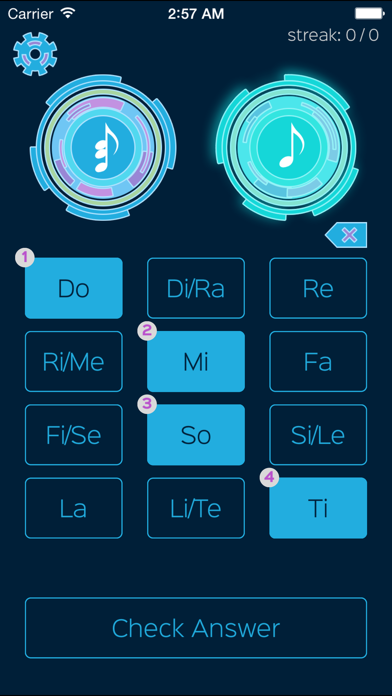- Pushes Ear Training. Ear training, or inner hearing, is all about recognizing patterns. Too often, musicians separate their solfege practice from the actual making of music. It’s not supposed to be that way! Using solfege when singing real songs like these rounds push your brain to connect the patterns and how they sound with real music.
- Training packs These packs of free ear training MP3s can help you learn with your computer or portable MP3 player. Practice aural skills on the move!
- In this episode we explore the two methods of Chromatic Solfege Singing and how they apply to Ear Training, Music Production, Performance and overall develop.
- Solfege Singing Trainer Wow Classic
- What Is Solfege
- Solfege Do Re Mi
- Solfege Singing Trainer Classic
- Solfege Help
If you have ever sung in a choir or taken voice lessons before, you have probably sung the major scale using solfege syllables. There are 7 unique pitches in this scale.
Sight Singing - Scales in Solfege Preparation for Unit 5 Sight Singing. Please click on the link below to access the sight singing assignment for next week. You must bring the assignment to your sight singing lesson. You may choose to print it out, or to view it on a laptop or tablet device.
Major Scale With Solfege Syllables
As singers, we use solfege in sight singing and ear training practice. If these solfege syllables are new to you, don’t worry they are super easy to learn!
Today I’m going to teach you how to sing this solfege scale in tune and a cappella (by yourself). I’ve also created a 4 part series of simple solfege ear training exercises to help improve your pitch. Check out part 1 of the series!
What is Ear Training, You Say?
Ear training is the practice of developing/improving your sense of pitch and harmony. Great singers sing in tune. When someone says “Wow, she’s got a great ear”, it doesn’t mean that the singer has really good hearing. It means that she has trained her ear (her brain, really) to be able to understand and sing pitches with great accuracy as well as to hear harmonies and improvise/riff by hearing “inside the chords”.
Why Should I Bother With Ear Training?
Because singing out of tune sounds bad! Even good singers will benefit from ear training. No matter how good of a singer you are, you can always find ways to improve your craft. Fine tuning and developing your ear is a way to take your singing to another level.
How To Practice
Practice with a piano or virtual keyboard. Play the major scale in the key of C as you sing Do-Re-Mi-Fa-Sol-La-Ti-Do. Sing up and down the scale. Once you can sing the scale in tune by yourself (without the help of the piano), try moving around the scale in stepwise motion. For example: Do-Re-Do-Re-Mi-Fa-Sol-Fa-Mi-Fa-Sol-La-Ti-La-Ti-Do etc.
You should make a little solfege chart like the one I use in the video. This way, you can practice the exercises at your own pace. You may need to move slower at first and that’s ok.

Need some help with naming notes on the keyboard? Check out this video tutorial and article- Piano Keys- A Simple Guide To Learning Notes On The Piano
Today I’m going to show you two solfege exercises that will help you sing more in tune and, with practice, enable you to audiate (or mentally hear) and sing the intervals of the major scale. This lesson focuses on hearing & singing the solfege syllables “Re” and “Ti”.
Solfege Singing Trainer Wow Classic
This is part 3 in a 4 part series. If you missed them, you can check out parts 1 & 2 here-
What Is Solfege
Solfege Syllables Training
A Little Bit Of History
Solfege syllables have been used for hundreds of years as a method to teach pitch & sight singing to aspiring musicians. There are two solfege systems used today: movable do and fixed do. At HowToSingSmarter.com (and most of the USA), we use movable do.
Solfege Do Re Mi
In the movable do system, “do” moves based on what key you are in. Any note on the keyboard can potentially be “do”. For instance, in the key of C, “do” is C. In the key of F, “do” is F. In the key of Eb, “do” is Eb and so on.
In the fixed do system, used throughout most of Europe, the syllables are always tied to specific pitches. The seven syllables (with Si instead of Ti) are used to name the notes of the C-Major scale, instead of the letters C, D, E, F, G, A and B.
Do=C, Re=D, Mi=E, Fa=F, Sol=G, La=A, Si=B
Both systems have there advantages, but the movable do system is great for developing relative pitch with ease. Relative pitch is the ability to find & sing a note by comparing it to a reference note. For example, if I play “Do” (in any key), a person with good relative pitch will be able to find & sing “Sol” or “Mi” or “Fa” etc.

Excellent relative pitch can be developed with ear training exercises like the ones in today’s tutorial video.
How To Practice
Sing along with the exercises in the tutorial video (in all twelve keys) to better hear “Re” and “Ti”.
Solfege Singing Trainer Classic
Exercise “Re”:
Exercise “Ti”:

Write out your own solfege syllables chart and practice jumping around the scale as demonstrated in the video.
Frequently jump to “Re” and “Ti” from various notes in the scale. Practice at a piano/virtual keyboard (in the key of C) so you can play the pitches you are having trouble hearing.
Solfege Help
Not sure how to play the C major scale on the piano? Learn how here- Learn How To Play And Sing The Major Scale
Enjoy Your Practice!
